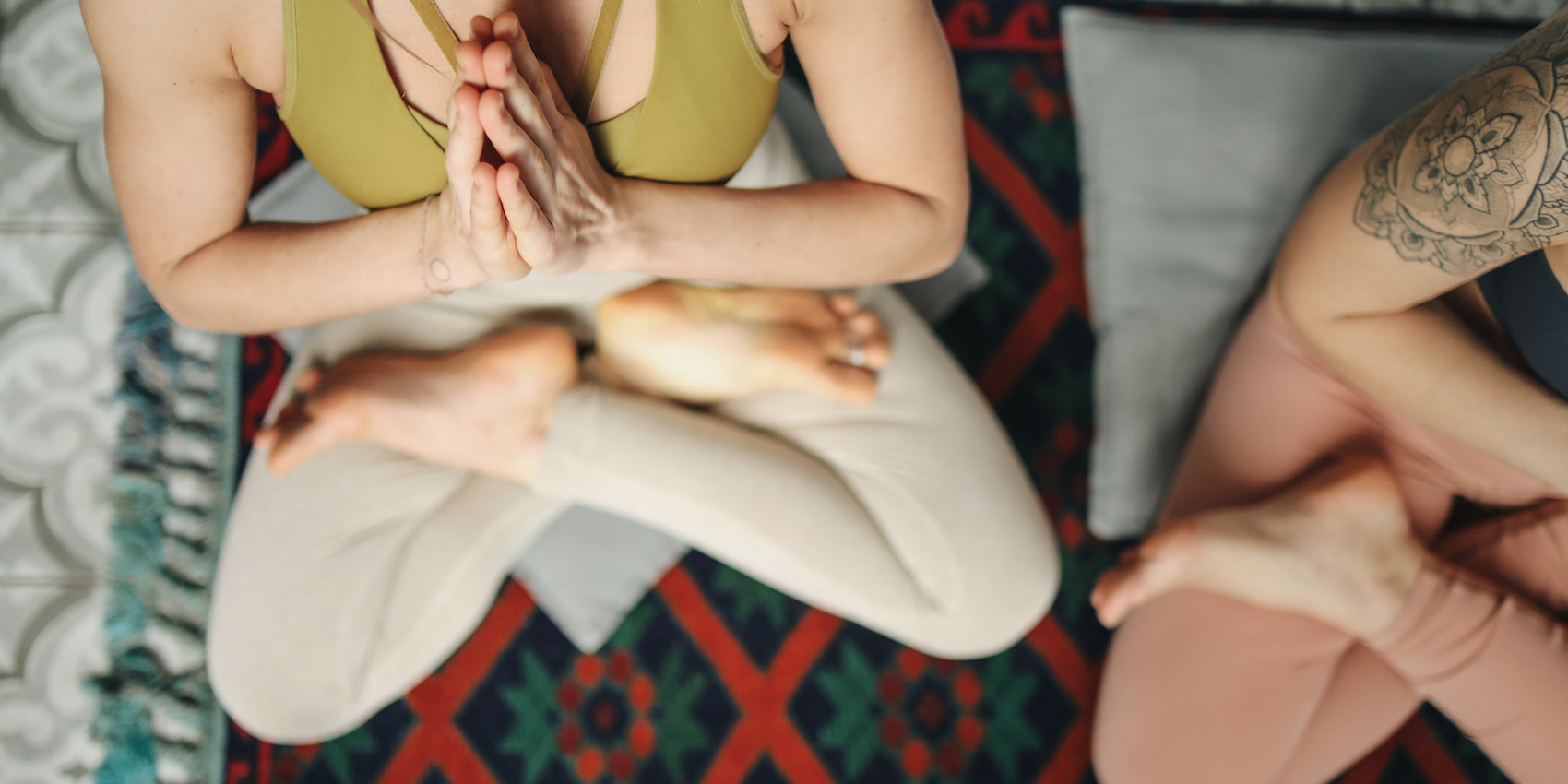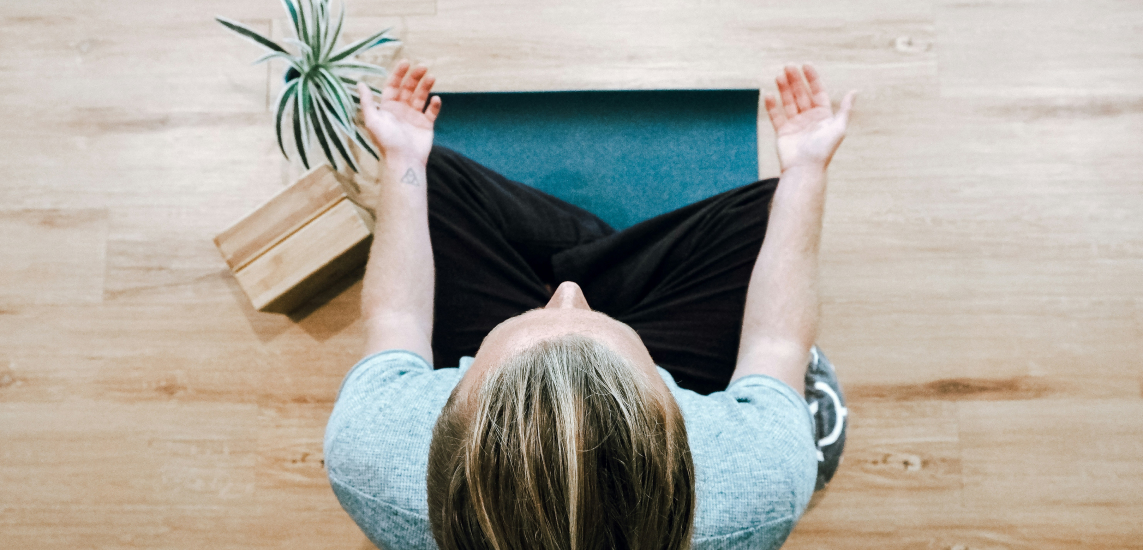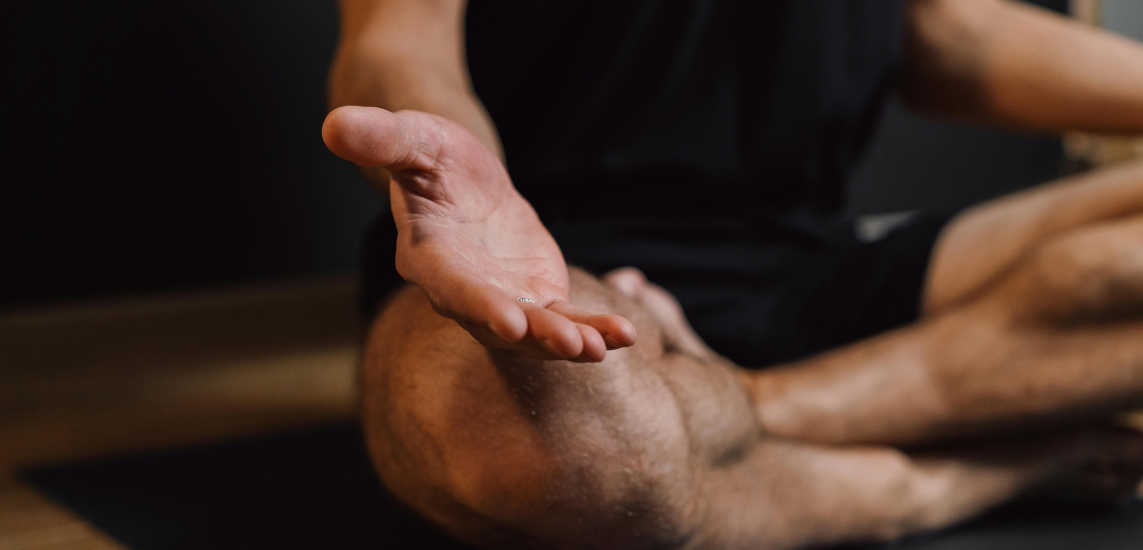Sitting with amazing posture during meditation is tough. When you’re trying to focus your busy mind, it’s easy to forget about your sitting posture. Not only does this get uncomfortable and distract you from your meditation, it can also lead to issues like back pain and headaches. This article explores 5 tips for a healthy meditation posture.
Healthy, Seated Meditation Posture: Why Does It Matter?
There are three main reasons why posture matters during seated meditation:
- It helps you feel more comfortable: Keeping the spine in its natural curve is more comfortable than slouching. Your back, neck and shoulders prefer to be in good alignment.
- It helps you concentrate: You’ve heard your meditation teachers say “sit upright in a comfortable position,” because comfort is key. Being distracted by discomfort can pull you out of your meditation and ruin your focus.
- It helps prevent pain: Slouching is a common cause of back pain and neck pain causing headaches. If you meditate for more than a few minutes in a slouched position, you can get really sore and achy in your back and neck. That’s the last thing you want from meditation.
5 Postural Tips For Seated Meditation
Great posture starts with maintaining the natural curve of the spine, which also makes us sit tall. Sitting up tall sounds easy, but it’s not intuitive for most of us, especially if we’re sitting on the floor unsupported. Instead of trying to sit up as tall as possible, concentrate on these tips. Once you understand what postural goals you’re aiming for, it’s much easier to sit for longer and achieve better focus with your meditation.
1. Allow Your Lower Back To Gently Sway
Your lower back (lumbar spine) is designed to stay in a gentle sway position most of the time, as that’s the position that allows it to absorb compressive forces best.
A sway position is a gentle curve that is concave when you’re looking at your spine from behind.
This is is how you can find this position in all seated positions: lotus, cross-legged and sitting in a chair:
- Place your hands on the bony part of your pelvis below your waist.
- Roll your pelvis forwards and backwards.
- When you roll your pelvis forwards, you’ll notice your lower back arches.
- When your pelvis rolls backwards, you’ll notice your lower back curves into a slouch.
- The ideal position for your lower back is in between these two extremes, so your lower back is gently arched.
By sitting on a block or blanket, you’ll be able to maintain this position more easily. You can also sit in this neutral spine position on a chair too.
If you can’t maintain this spinal position for your entire meditation session, try sitting against a wall or on a chair with a small roll in your lumbar spine. You can buy a lumbar roll, or make your own by rolling a towel up and placing it in the gap of your lower back.
Read more: Explore how to deal with lower back pain during meditation and explore these helpful guided meditations:
- Releasing Tension: Low Back Paige Gilchrist 19:26
- Supple Low Back Margaret Rinaldi 22:29
- Relieve Low Back Pain With Movement Dayana 29:44
- Soothe & Heal Your Spine Jac Godsman 08:47
- Compassion Meditation For Back Pain The BioMedical Institute of Yoga and Meditation 09:02
- The Tension Release Meditation Vidyamala Burch 05:45
- Breath and Spine Kerri White 27:25
2. Keep Your Knees And Thighs Lower Than Your Pelvic Rim
If you find your knees fly up when you sit cross-legged on the floor, you won’t be able to achieve the neutral spine position described above. Tight hips, joint stiffness, arthritis and FAI (a non-serious condition in the hips that makes rotation uncomfortable) can all contribute to a lack of hip mobility in a cross-legged or lotus position.
If this is where you’re at, no problem. You can still achieve great posture with a few props.
- Try sitting up on a block or stack of pillows. This allows your knees to be lower than your pelvis. If you need a large stack of blankets, that’s fine.
- Try sitting on a comfortable chair where your knees are slightly lower than your hips.
Remember, sitting directly on the ground with your legs crossed is not the ultimate goal of meditation. As long as your posture is good and you’re comfortable, keep your focus on your mind. If sitting in a chair works best for you, go for it!
Read more: Yin yoga can stretches and lengthens the body’s connective tissue with long slow holds. Explore the many benefits of yin yoga for the body, mind and soul.
3. Keep Your Chin Back Over Your Collar Bone
Where you hold your head can have a huge bearing on your balance and posture during meditation. A poked chin posture is one of the leading causes of neck pain, headaches and even nerve irritation down the arms and hands. The tricky thing is, it’s hard to know if your chin is poking forwards unless someone tells you. So always assume it is, so you can reset.
- Once your lower back and pelvis are in a comfortable position, draw your chin backwards over your collarbone. Imagine you’re making a double chin to achieve this movements.
- Try not to look up or down, keep your eye gaze straight ahead.
- If your eyes are closed during meditation, don’t let your head nod downwards. It can put extra pressure in the upper cervical spine, leading to headaches.
Read more: Learn how to alleviate common soreness and pain during meditation — from knees to neck.
4. Keep Your Ribs Down
When we are little, we’re often told to sit up as tall as possible. We do this by forcing our chest forwards which pulls our ribs upwards. Rib position may not sound important, but don’t forget your ribs attach to your thoracic spine at the back.
When your ribs are lifted, also known as ‘flared,’ the middle back (thoracic spine) is forced into an extended position. This pushes your lower spine forwards too and your pelvis has to rotate forwards to prevent you from toppling over. This flared position also puts pressure on the thoraco-lumbar junction, where the middle back meets the lower back. This spot can become a sore point after sitting for just a few minutes in this posture, leading to a genuine irritation after a solid meditation session.
The secret is to lower the ribs without hunching your shoulders.
- Place your hands on your lower ribs and gently press them down into yourself.
- Imagine your ribcage is a floating pontoon, and you’re lowering the pontoon into the water.
- If it feels too tricky to lower your ribs in sitting, practice it while lying on your back.
If your thoracic spine is very stiff, you’ll find lowering your ribs difficult, so try some spinal twists and foam rolling to free up your middle back. This will make it easier to lower your ribs and help you achieve comfortable meditation posture.
5. Keep Your Shoulder Open
We know hunching during meditation isn’t good, but it’s handy to know why. ‘Shoulders back!’ is a common phrase we often hear when we’re young, but we overdo it. This ‘shoulders back’ position leads to rib flaring and the position described above.
So, instead of thinking of keeping your shoulders back, think of opening them instead.
- Find the bony prominence on the tip of your shoulder. It’s located at the back of the shoulder’s tip.
- Instead of pulling the shoulders back, think of rotating this bony prominence backwards.
- Another way to think of it is to imagine increasing the space from your sternum to the end of your collarbone by opening the shoulders.
Healthy Meditation Posture: Find Your Comfort
Great meditation posture doesn’t just look fantastic, it’s important for preventing discomfort. This boosts your ability to focus your mind and calm your busy thoughts as best as possible. If you’re finding it too uncomfortable to sit on the floor, sit on a chair instead. Consider the five postural tips above whether you’re in a chair, on a pillow or sitting on a block and you’ll find you’re more comfortable and can concentrate better during meditation.
Remember: Back pain and other discomfort-causing sensations are common during meditation mostly because cross-legged meditation requires great strength to maintain perfect posture. If the discomfort does not become unbearable, the sensation can become a powerful focus object for your meditation. Learn about the important role of discomfort for personal and spiritual growth. These selected guided meditations can help to embrace and work with discomfort:
- Sitting Through Discomfort Mel A. James 11:25
- Working with Difficult Bodily Sensations Hugh Byrne 15:08
- Breathing Through Pain And Discomfort Jamie Krasman 9:34
- Sit With Your Discomfort Jelena Fu 10:10
- Pain and Discomfort Meditation Joelle Anderson 20:00
- Gratitude Practice For Discomfort And Difficulty Dr. Candice Creasman 10:02
- Finding A Way Through Physical And Emotional Discomfort Anne Marie Wallen 23:02
- Accepting Emotional Discomfort Dr. Julien Lacaille (MindSpace) 16:13
- Beyond Pain Mary Maddux 15:46
- Making Peace With Physical Discomfort Andrea Zimmering 08:05
- From Pain to Peace Bethany Auriel-Hagan 15:36
- Journey Through Pain Short Version Andy Hobson 13:51
- Resting With Discomfort Lisa Meuser 10:09
- Sitting With Discomfort A. M. Wegner 9:59
- Learning To Sit With Discomfort Kate Heironymus 9:55
- Meditation for Comfort & Ease in the Body Jennifer Meek 10:00




-1.jpg)



